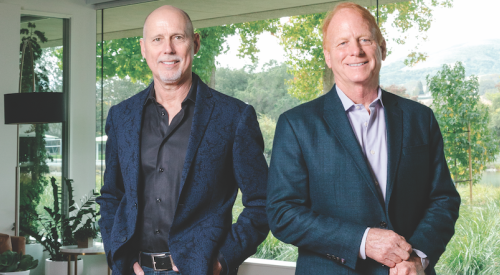| Henry Cisneros and Kaufman and Broad CEO Bruce Karatz announced a joint venture to build homes on infill sites throughout the West.
|
A long-held belief about succeeding in the infill home building business is about to be tested. The notion is that success with infill is largely a function of a builder’s deep knowledge of a particular city as well as strong ties to government officials that come from being based locally.
With the announcement last month that it will partner with Henry Cisneros, former secretary of Housing and Urban Development, to build infill projects across a wide swath of the country, Kaufman and Broad Home Corp. is betting that big builders can also get the job done by combining economies of scale and heavy political clout.
With KB providing the construction personnel and expertise, and a Cisneros-led team handling site selection and entitlement, the new firm plans to begin simultaneously building homes in dozens of large cities across the West -- namely the fast-growing states of Texas, Nevada, Colorado, Arizona and California. Within three years, the plan calls for American CityVista to build 2,000 single-family detached and townhouse units a year.
Other national home builders will undoubtedly monitor the progress of the venture with an eye toward similar initiatives. But according to CEO Bruce Karatz, American CityVista is a unique opportunity -- born as much out of the opportunity to partner with Cisneros in an area where he has unequaled clout and experience as it is about a vision to capitalize on the strong demand for affordable homes in urban centers. In short, other builders will be pressed to find another Cisneros.
"Over the past 15 years, there are lots of examples of where Kaufman and Broad has built infill housing," Karatz says. "It’s never been a large part of our business; it is just that Henry is very interested in it. He obviously understands housing markets. So we are just taking advantage of his interests to expand in a market where we have had some experience."
The ambitious scale of American CityVista is also recognition of the fact that home building in cities is emerging as a high priority for urban leaders faced with shortages of housing for average-income workers.
Jerry Brown, mayor of Oakland, Calif., is a good example. In June, at the Western Building Show, he unveiled an initiative to build approximately 10,000 homes in downtown Oakland and invited builders to talk with him personally about project ideas.
The assumption is that Cisneros will be in contact with Brown to discuss the prospects for an American CityVista project in Oakland. And one can suppose that Brown and other big-city mayors might be more willing to give full support to a project involving a telegenic former Cabinet member.
| American CityVista Initial Cities for Development
Texas: San Antonio, Dallas, Houston, Austin, Laredo, McAllen, Edinburg, Brownsville, Harlingen Arizona: Phoenix, Tucson Nevada: Las Vegas Colorado: Denver California: Los Angeles, L. A. County, Orange County (Anaheim/Santa Ana), San Bernardino/Riverside, San Diego, San Jose, Santa Clara County, Oakland/East Bay, Monterey County/Salinas, Sacramento, Modesto, Stockton, Fresno, Bakersfield Source: American CityVista, 2000 |
For Cisneros, American CityVista is both an experiment and a tribute to KB’s commitment to housing.
"These homes will offer high-tech wiring and all of the option choices available to suburban buyers," Cisneros tells Professional Builder. "The story here is that a big suburban builder has chosen to build homes in inner cities targeted to average-income buyers -- not the very low end or the gentrified high end."
No Real Downside Risk
Perhaps the closest thing to American CityVista is The Olson Co. of San Diego. The successful infill firm recently opened a division outside of its Southern California base to serve San Francisco and other metropolitan areas in northern California. But American CityVista’s plans are on a different order of magnitude.
To reach the goal of building 2,000 units per year within three years, Karatz says he expects American CityVista to break ground on a number of projects before the end of the year and that the minimum project size will be approximately 100 units. Importantly, American CityVista will operate only in markets where KB already has an established home building division. In this way, the company can avoid the many costs of establishing new offices.
From a Wall Street perspective, the jury is out. Analysts have not made up their minds about how the deal will affect KB’s bottom line. This is partly because it is expected to be months before the new venture’s pipeline is filled with projects and even longer before these developments start to affect KB’s revenue stream.
Analysts are generally more concerned with shorter-term issues such as interest-rate fluctuations. That said, buy-side analyst Samuel A. Lieber of Alpine Asset Management & Research LLC sees a number of potential benefits for Kaufman & Broad in launching American CityVista and very little downside.
"In the long term, it is probably a pretty smart move for the company," says Lieber. "I think this program introduces what in essence could be a future stream of buyers for KB homes. And presumably, if they do a good job, it will engender a lot of goodwill."
For Lieber, an important question about the deal is the level of investment required by KB -- a figure that the company declines to give -- and the expected rate of return on the investment. When compared with what KB might have been able to generate by investing the same amount in a more traditional expansion of home building activity, the venture’s progress will be easier to benchmark.
Under terms of the deal, Cisneros will own more than 50% of the company.
"Is this a diversion of resources to an area that is going to have a lower return on investment? I don’t know," says Lieber. "In the scheme of things, I think this falls into the realm of being a good corporate citizen, and that is never bad in terms of getting local government to help you with entitlements."
A reduced share of the burden of securing entitlements is a positive element of the venture for KB. Most of the margin pressure typically associated with doing infill housing comes as a result of numerous bureaucratic obstacles encountered during the land buying and entitlement process. With Cisneros’ team handling the front end of each project, KB can expect to come in and build each project without diverting extra company resources to nail down the many details.
One of the details that holds the continued potential to put margin pressure on KB’s piece of the American CityVista venture will be the amount of below-market-rate housing each municipality requires.
Cisneros says he anticipates very few projects of this nature. Karatz does, too. The goal, he says, will be to build market-rate housing for people earning at or about the median income. "We think there is a tremendous unfilled demand for this kind of housing."












